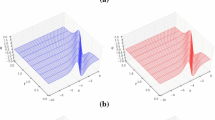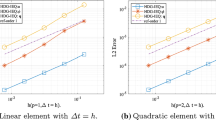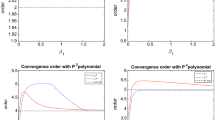Abstract
We develop and analyze a new hybridizable discontinuous Galerkin method for solving third-order Korteweg–de Vries type equations. The approximate solutions are defined by a discrete version of a characterization of the exact solution in terms of the solutions to local problems on each element which are patched together through transmission conditions on element interfaces. We prove that the semi-discrete scheme is stable with proper choices of stabilization function in the numerical traces. For the linearized equation, we carry out error analysis and show that the approximations to the exact solution and its derivatives have optimal convergence rates. In numerical experiments, we use an implicit scheme for time discretization and the Newton–Raphson method for solving systems of nonlinear equations, and observe optimal convergence rates for both the linear and the nonlinear third-order equations.


Similar content being viewed by others
References
Biswas, H.A., Rahman, A., Das, T.: An investigation on fiber optical solution in mathematical physics and its application to communication engineering. IJRRAS 6(3), 268–276 (2011)
Bona, J.L., Chen, H., Karakashian, O., Xing, Y.: Conservative, discontinuous Galerkin-methods for the generalized Korteweg–de Vries equation. Math. Comput. 82(283), 1401–1432 (2013)
Bona, J.L., Chen, H., Sun, S.-M., Zhang, B.-Y.: Comparison of quarter-plane and two-point boundary value problems: the KDV-equation. Discrete Contin. Dyn. Syst. Ser. B 7(3), 465–495 (2007)
Bona, J.L., Sun, S.-M., Zhang, B.-Y.: A nonhomogeneous boundary-value problem for the Korteweg–de Vries equation posed on a finite domain. Commun. Partial Differ. Equ. 28(7–8), 1391–1436 (2003)
Bona, J.L., Sun, S.-M., Zhang, B.-Y.: A non-homogeneous boundary-value problem for the Korteweg–de Vries equation posed on a finite domain II. J. Differ. Equ. 247, 2558–2596 (2009)
Braginskii, S.I.: Transport processes in a plasma. Rev. Plasma Phys. 1, 205 (1965)
Buckingham, M.: Theory of acoustic attenuation, dispersion, and pulse propagation in unconsolidated granular materials including marine sediments. J. Acoust. Soc. Am. 102(5), 2579–2596 (1997)
Chen, Y., Cockburn, B., Dong, B.: Superconvergent HDG methods for linear, stationary, third-order equations in one-space dimension. Math. Comput. 85, 2715–2742 (2016)
Chen, Y., Cockburn, B., Dong, B.: A new discontinuous Galerkin method, conserving the discrete \(H^2\)-norm, for third-order linear equations in one space dimension. IMA J. Numer. Anal. 36(4), 1570–1598 (2016)
Cheng, Y., Shu, C.-W.: A discontinuous Galerkin finite element method for time dependent partial differential equations with higher order derivatives. Math. Comput. 262, 699–730 (2008)
Cockburn, B., Dong, B., Guzmán, J.: A superconvergent LDG-hybridizable Galerkin method for second-order elliptic problems. Math. Comput. 77, 1887–1916 (2008)
Cockburn, B., Fu, Z., Hungria, A., Ji, L., Sánchez, M., Sayas, F.-J.: Stormer–Numerov methods for the acoustic wave equation (submitted)
Cockburn, B., Gopalakrishnan, J., Lazarov, R.: Unified hybridization of discontinuous Galerkin, mixed and continuous Galerkin methods for second order elliptic problems. SIAM J. Numer. Anal. 47, 1319–1365 (2009)
Cockburn, B., Gopalakrishnan, J., Sayas, F.-J.: A projection-based error analysis of HDG methods. Math. Comput. 79, 1351–1367 (2010)
Cockburn, B., Guzmán, J., Wang, H.: Superconvergent discontinuous Galerkin methods for second-order elliptic problems. Math. Comput. 78, 1–24 (2009)
Cockburn, B., Gopalakrishnan, J.: The derivation of hybridizable discontinuous Galerkin methods for Stokes flow. SIAM J. Numer. Anal. 47, 1092–1125 (2009)
Goubet, O., Shen, J.: On the dual Petrov–Galerkin formulation of the KdV equation on a finite interval. Adv. Differ. Equ. 12(2), 221–239 (2007)
Holmer, J.: The initial-boundary value problem for the Korteweg–de Vries equation. Commun. Partial Differ. Equ. 31, 115–1190 (2006)
Horsley, S.A.R.: The KdV hierarchy in optics. J. Opt. 18, 085104 (2016)
Hufford, C., Xing, Y.: Superconvergence of the local discontinuous Galerkin method for the linearized Korteweg–de Vries equation. J. Comput. Appl. Math. 255, 441–455 (2014)
Kamchatnov, A.M., Shchesnovich, V.S.: Dynamics of Bose–Einstein condensates in cigar-shaped traps. Phys. Rev. A 70(02), 023604 (2004)
Karakashian, O., Xing, Y.: A posteriori error estimates for conservative local discontinuous Galerkin methods for the generalized Korteweg–de Vries equation. Commun. Comput. Phys. 20, 250–278 (2016)
Liu, H., Yan, J.: A local discontinuous Galerkin method for the Korteweg–de Vries equation with boundary effect. J. Comput. Phys. 215, 197–218 (2006)
Nguyen, N.C., Peraire, J., Cockburn, B.: An implicit high-order hybridizable discontinuous Galerkin method for nonlinear convection–diffusion equations. J. Comput. Phys. 228, 8841–8855 (2009)
Panda, N., Dawson, C., Zhang, Y., Kennedy, A.B., Westerink, J.J., Donahue, A.S.: Discontinuous Galerkin methods for solving Boussinesq–Green–Naghdi equations in resolving non-linear and dispersive surface water waves. J. Comput. Phys. 273, 572–588 (2014)
Phillips, O.: Nonlinear dispersive waves. Annu. Rev. Fluid Mech. 6, 93–110 (1974)
Samii, A., Panda, N., Michoski, C., Dawson, C.: A hybridized discontinuous Galerkin method for the nonlinear Korteweg–de Vries equation. J. Sci. Comput. 68, 191–212 (2016)
Schamel, H.: A modified Korteweg–de Vries equation for ion acoustic waves due to resonant electrons. J. Plasma Phys. 9(3), 377–387 (1973)
Shukla, P.K., Eliasson, B.: Colloquium: nonlinear collective interactions in quantum plasmas with degenerate electron fluids. Rev. Mod. Phys. 83(3), 885–906 (2011)
Skogestad, J.O., Kalisch, H.: A boundary value problem for the KdV equation: comparison of finite-difference and Chebyshev methods. Math. Comput. Simul. 80, 151–163 (2009)
Tagare, S.G.: Effect of ion temperature on propagation of ion-acoustic solitary waves of small amplitudes in collisionless plasma. Plasma Phys. 15(12), 1247 (1973)
Tassi, E., Morrison, P.J., Waelbroeck, F.L., Grasso, D.: Hamiltonian formulation and analysis of a collisionless fluid reconnection model. Plasma Phys. Control. Fusion 50(8), 1–29 (2008)
Tran, M.Q.: Ion acoustic solitons in a plasma—a review of their experimental properties and related theories. Phys. Scr. 20, 317–327 (1979)
Xu, Y., Shu, C.-W.: Error estimates of the semi-discrete local discontinuous Galerkin method for nonlinear convection–diffusion and KdV equations. Comput. Methods Appl. Mech. Eng. 196, 3805–3822 (2007)
Xu, Y., Shu, C.W.: Optimal error estimates of the semidiscrete local discontinuous Galerkin methods for high order wave equations. SIAM J. Numer. Anal. 50, 79–104 (2012)
Yan, J., Shu, C.W.: A local discontinuous Galerkin method for KdV type equations. SIAM J. Numer. Anal. 40, 769–791 (2002)
Zabusky, N.J., Kruskal, M.D.: Interaction of “Solitons” in a collisionless plasma and the recurrence of initial states. Phys. Rev. Lett. 15, 240–243 (1965)
Acknowledgements
The author would like to acknowledge the support of National Science Foundation Grant DMS-1419029.
Author information
Authors and Affiliations
Corresponding author
Appendix: Implementation
Appendix: Implementation
To implement the HDG method (2.2), we use an implicit scheme for the discretization of the time derivative. One may use high order BDF or an implicit Runge–Kutta method for time discretization. Here, for simplicity we consider the backward Euler method with time-step \(\Delta t\). At time-level \(t_j\), inserting the definition of the numerical traces (2.2e) into (2.2a)–(2.2e), we obtain the equations
from which \((u_h, q_h, p_h)\) can be locally solved in terms of \(f,\,\widehat{u}_h\) and \(\widehat{p}_h^{\,-}\), and the equations
which determine the globally coupled unknowns \((\widehat{u}_h, \widehat{p}_h^{\,-})\).
Next, we apply the Newton–Raphson method to solve the above nonlinear system. Denoting the approximations at the current iteration by \((\bar{u}_h, \bar{q}_h, \bar{p}, \bar{\widehat{u}}_h, \bar{\widehat{p}}_h^{\,-})\in W_h^k\times W_h^k\times W_h^k\times M_h(u_D)\times \tilde{M}_h\), we want to find the increments \((\delta u_h, \delta q_h, \delta p_h, \delta \widehat{u}_h, \delta \widehat{p}_h^{\,-}) \in W_h^k\times W_h^k\times W_h^k\times M_h(0)\times \tilde{M}_h\) such that
and
for any \((v, z, w, \mu ,\chi )\,\in \,W_h^{k}\times W_h^{k} \times W_h^{k}\times \tilde{M}_h\times M_h(0)\), where
Here we have used the notation \(\bar{\tau }_F:=\tau _F(\bar{\widehat{u}}_h, \bar{u}_h)\), and \(\partial _1 \bar{\tau }_F\) (respectively, \(\partial _2\bar{\tau }_F\)) denotes the first-order partial derivative of \(\tau _F\) with respect to the first argument (respectively, second argument) evaluated at \((\bar{\widehat{u}}_h, \bar{u}_h)\).
The discretization of the system above gives rise to matrix equations of the form
and
From (5.1), we get
We emphasize that the above inverse can be computed on each element independently of each other since the matrices \(A_1, A_2,A_3, B_1, B_2\) and C are block-diagonal owing to the discontinuous nature of the approximation spaces. Applying (5.3)–(5.2), we get the global linear system
where
and
Therefore, the only globally coupled degrees of freedom are those associated with \(\delta \widehat{u}_h\) and \(\delta \widehat{p}_h^{\,-}\), which live only on element interfaces. Due to the one-dimensional setting of the KdV equation, the size and the bandwidth of the global linear system are independent of the degrees of polynomials used; it only depends on the number of subintervals in the mesh. Once \(\delta \widehat{u}_h\) and \(\delta \widehat{p}_h^{\,-}\) are obtained, \((\delta p_h, \delta q_h, \delta u_h)\) can be locally computed by using (5.3).
Rights and permissions
About this article
Cite this article
Dong, B. Optimally Convergent HDG Method for Third-Order Korteweg–de Vries Type Equations. J Sci Comput 73, 712–735 (2017). https://doi.org/10.1007/s10915-017-0437-4
Received:
Revised:
Accepted:
Published:
Issue Date:
DOI: https://doi.org/10.1007/s10915-017-0437-4
Keywords
- Hybridizable discontinuous Galerkin methods
- HDG
- DG
- Korteweg–de Vries (KdV) equation
- Third-order equations




